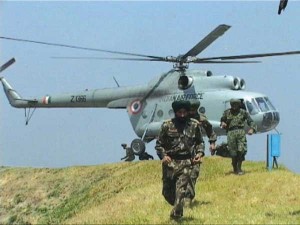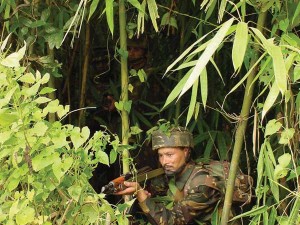Australian Theatre Command. HQ Australian Theatre (HQ AST) was established in June 1997. The aim was to separate the Australian political strategic level from war fighting, discontinue the adhoc approach to co-ordination and control of operations, institute unity of command at the operational level and provide a standing capability for planning campaigns, operations and specific activities. HQ AST does not have any forces permanently assigned to it. Appropriate forces are allocated to the Commander Australian Theatre (COMAST) by the Chief of Defence Force (CDF) for specific operations15.
The CDF maintains full command over the Australian Defence Forces (ADF). However, the service chiefs command their respective services and are responsible to raise, train and sustain them. When the CDF orders the conduct of an operation or a campaign, he directs the service chiefs to assign appropriate forces at a specified level of capability to COMAST. The AST has component commanders from the individual services. They provide expert advice concerning the operational employment of the assigned forces. This arrangement ensures appropriate theatre focus with emphasis on initiation, sequencing and manoeuvring series of joint operations. HQ AST houses component commanders’ alongwith adequate number of permanent staff. This organisation is permanently available under the Theatre Command.
Some US articles lament that Air power is undervalued in the US joint doctrines and war plans. Land forces dominate the Theatre Commands (TC) with strong influence.
The HQ AST is also supported by the Australian Joint Intelligence Centre (ASTJIC) and the 1st Joint Movement Group that is responsible to secure civil strategic lift assets. The ASTJIC provides fused intelligence picture of the theatre. The Joint Operations Command reports directly to the CDF, thus bringing under his command, Strategic Operations Division, HQ AST, HQ Northern Command (NORCOM) and Deployable Joint Forces HQ. NORCOM is a permanent joint HQ and during operations is tasked with vital asset protection, surveillance and covering operations.
Analysis of US and Australian Theatre Commands. Analysis of the two command structures highlights some commonalities. Both are structured for joint application of force generally for OOAC’s and in support of the multinational forces rather than for homeland defence. The aim is to provide a unified command for operational employment of joint forces. Though the appointments and staff for planning and conduct of operations is permanent in the Australian model, the forces are allotted by the individual service HQ based on a joint appreciation of the impending threat. Whilst Americans have global aspirations, the ADF is employed more in support of multinational forces. In both cases, the meaning of theatres relates to large contiguous masses that translate itself to the size of continents. In our context, our war on terror is fought generally within our country and our most immediate concerns relate more to homeland defence. Hence, we need to look at structures that take care of threats ranging from asymmetric to conventional wars fought in a nuclear environment and focussed more to our subcontinent.
Limitations of Western Concept. Even with the employment of Theatre Command concept, the problems between Lt Gen Clark and Lt Gen Short affected campaign planning in Kosovo operations. In Op Anaconda too, senior Army Commanders were widely criticised by their air and naval counterparts for not co-ordinating with them effectively during the weeks preceding the commencement of the conflict16. Thus clearly highlighting that unified structures can only facilitate forcible co-operation this far but the true test of actual jointmanship lies in dismantling established mindsets.
 Some US articles lament that Air power is undervalued in the US joint doctrines and war plans. Land forces dominate the Theatre Commands (TC) with strong influence. The belief is wide spread that “boots on ground” are more important than precision strikes. The ground forces definition of a joint operation is one in which they are supported by air power, the notion that air power might achieve anything alone or with land or sea forces in support is heresy. Maj Gen Charles D Link of USAF states that Airpower not in support of land forces is considered ‘unjoint’17. Own structures would need to find solutions for these limitations.
Some US articles lament that Air power is undervalued in the US joint doctrines and war plans. Land forces dominate the Theatre Commands (TC) with strong influence. The belief is wide spread that “boots on ground” are more important than precision strikes. The ground forces definition of a joint operation is one in which they are supported by air power, the notion that air power might achieve anything alone or with land or sea forces in support is heresy. Maj Gen Charles D Link of USAF states that Airpower not in support of land forces is considered ‘unjoint’17. Own structures would need to find solutions for these limitations.
Options For Unified Command Structures. The options for unified command structure comprise developing Joint Theatre Commands at the Army Command HQ level or developing geographically based Theatre Command structures or evolving a TC at the national level that provides a unified command structure that integrates the operational employment of the three services as part of India Strategic Theatre (IST). Ideally, the chosen structure should be such that it requires bringing about minimum changes to the existing organisations and yet achieves the desired integration to co-ordinate a jointly evolved strategic art at the operational level.
First Option. The first option of developing TC’s at the Army Command HQ level would entail the theatre, for example, NC/WC/SWC (Army) to be restricted to an AOR of 150-200 Km by 150-200 Km on both sides of the border. This implies that the airpower assets would be distributed in penny packets within these Commands on three to four airfields located within their AOR. The IAF’s combat strength has effectively come down to 30 Squadrons18. Though technologically more potent, the reduced numbers limit the decentralisation down from the existing IAF Command Area of Responsibility to the Army Command AOR’s. Further, during the initial stages of the war, the primary air campaign is Counter Air Campaign. This campaign ensures that land and naval operations are carried out unhindered. These operations are executed centrally at the present IAF Command level to optimise employment of limited resources. Distributing scarce air assets at several TCs would result in significantly degrading the overall combat potential of the IAF19.
 This option would also cause substantial Air Space Management problems as several missions of this theatre would over fly other theatres due to location of targets or for tactical routing purposes to cater to the long reach of modern Air Superiority Fighters. This reach has been further enhanced with Air to Air Refuellers that themselves are centrally controlled by Air HQ and are based at deeper airbases. In addition, the strategic fighters such as Su-30 aircraft too are likely to be based outside the AOR of the TC to incorporate survivability aspects.
This option would also cause substantial Air Space Management problems as several missions of this theatre would over fly other theatres due to location of targets or for tactical routing purposes to cater to the long reach of modern Air Superiority Fighters. This reach has been further enhanced with Air to Air Refuellers that themselves are centrally controlled by Air HQ and are based at deeper airbases. In addition, the strategic fighters such as Su-30 aircraft too are likely to be based outside the AOR of the TC to incorporate survivability aspects.
During the course of the war, the focus may change from one theatre to the other and there may thus be a need to employ higher quantum of air effort centrally towards tackling emergent situations there. If under different TCs, it would become difficult to co-ordinate and employ air assets that over fly different theatres in a focussed manner on day to day basis. Even when the US/Australians employ air power in TCs, the numbers of combat aircraft employed range from 1200 to 2780 (Kosovo Operations – Gulf War I) and size of the theatre encompasses more than two countries. Hence this option for developing TCs is considered absolutely unsuitable.




